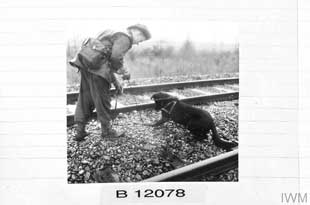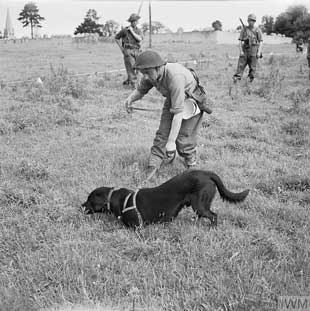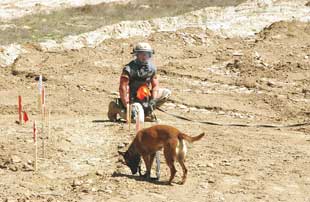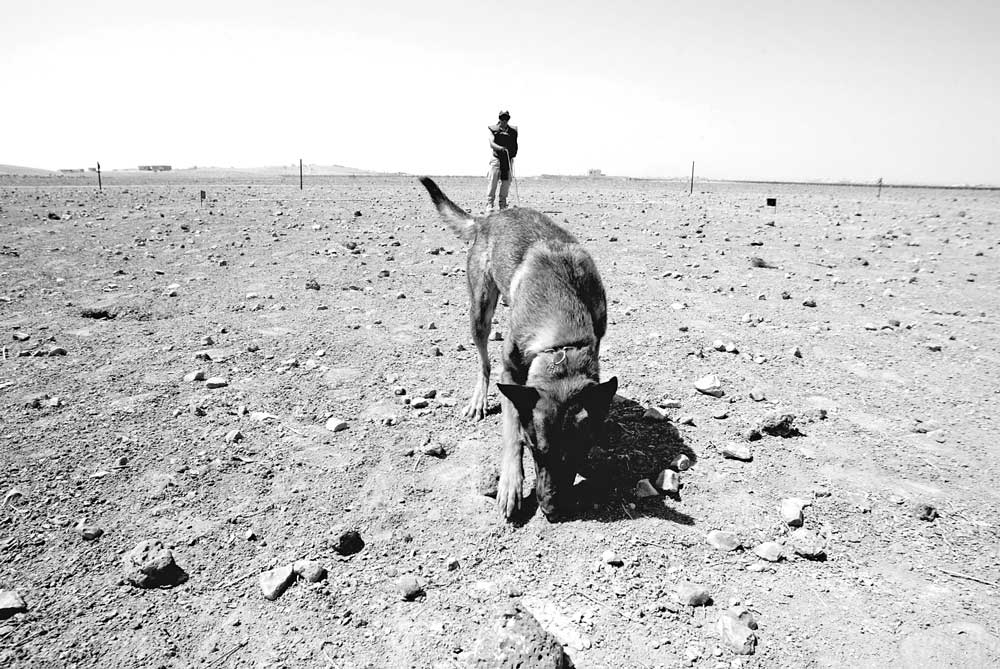A Brief History of Mine Detection Dogs
By Roly Evans [ Geneva International Centre for Humanitarian Demining ]
CISR JournalThis article is brought to you by the Center for International Stabilization and Recovery (CISR) from issue 26.1 & 2 of The Journal of Conventional Weapons Destruction available on the JMU Scholarly Commons and Issuu.com
Since their first use in World War II, the use of Mine Detection Dogs (MDDs) has been subject to ongoing debate. How effective are they really in finding mines? Are they really worth the expense they entail? As with so many aspects of modern survey and clearance operations, many of the lessons we continue to learn today have already been learned in the past. A brief history of the contribution of MDDs over the past eight decades can help us put their performance into perspective and understand where they can add significant value, while also appreciating their limitations.
World War II

A labrador from a Royal Engineers Dogs Platoon checking the railway line between America and Deurne in eastern Holland, 25 November 1944. MDDs were deemed more effective at searching areas with suspected nuisance mining rather than finding individual mines in a minefield. MDDs were partially effective at detecting individual minimum metal mines not laid in a pattern. Image courtesy of the Imperial War Museum (B.12078).
While mines had been used before, World War II was the conflict that saw the landmine coming of age as a major weapons system. The first documented use of MDDs during the Second World War is not clear. One French source states that the Russians were first, claiming “that as many as 100,000 mines were detected by these animals on roads, in towns and villages, and at bridgeheads,” and, incredibly, “one especially talented dog located almost 2,000 mines in one three-week period.”1 There is little to corroborate these extravagant claims.
The United Kingdom probably led the way in the early development of a MDD capability. From 1942, the development of mines with reduced metal content, even the simplest models, such as the Schützenmine 42, presented a significant detection problem. The available metal detectors could not be used to reliably detect these models, especially in heavily metal-contaminated conditions.2,3 Within this context, trials commenced in early 1943 at the new Obstacle Assault Centre (OAC) where much of the UK research into mine detection took place. The last of these trials involved searching a 1 kilometer stretch of road using three MDDs. The road was also searched by a sapper with a No.5 detector. The mine targets were emplanted twenty-four hours before the trial. The dogs took thirty-two minutes to complete the task, slower than the sapper with a detector at twenty-two minutes. However, the dogs found nine out of ten targets, the detector just four out of ten. Notably, the detector could not find Schützenmine 42s, that in the context of the detectors of the day, were deemed a minimum metal mine.4 The demonstrated potential of the MDD was enough for four Royal Engineers Dog Platoons to be formed in April 1944 for subsequent use during Operation Overlord in Normandy and thereafter.5

“Bobs,” a black labrador from No.1 Dog Platoon searches for mines in Bayeux, Normandy, 5 July 1944. The white cones on the handler’s belt are used to mark where the dog has indicated for subsequent investigation by a detector and excavation. The Royal Engineers Dogs Platoons in Normandy did not perform as well as had been hoped during their training. Image courtesy of the Imperial War Museum (B.6501).
The record of the Royal Engineers Dog Platoons, from the initial deployment of No.1 Dog Platoon in June 1944 until the end of the war in northern Germany, was mixed. During clearance of Carpiquet Airfield, to the west of Caen, between July and August 1944, an inauspicious start saw the MDDs miss numerous mines and the platoon commander losing his foot in a demining accident.6 MDDs frequently failed to reproduce the capability demonstrated in training in actual field conditions. The heat and the dust of the former battlefield was deemed particularly challenging for the dogs. The disappointing performance was acutely felt since the uneven surface made mechanical roller attachments ineffective, and the extensive metal contamination, standard for areas that had seen heavy fighting, made electronic detectors ineffective.7
In November 1944, the Dog Platoons moved to the Netherlands where eventually all four would work over the winter of 1944–45. While the Dog Platoons demonstrated their usefulness, they were deemed “not 100% effective.”8 It was decided that the dogs were not reliable enough to be used on known minefields but were better suited for “routine checking of suspect areas and the proving of and delimiting of areas in which mines were rumored to exist.” To this end, 155 miles of railway line, 73 miles under high-tension cables and 77,000 square yards, were searched by ‘war dogs’ with twenty-nine mines located. Building on the lessons of Normandy it was reconfirmed that using dogs was “fully justified on large areas of non-metallic anti-personnel mines.”9,10,11 As the Chief Engineer of the Second Army wrote in December 1944, MDDs “provide the quickest method of locating minefields and subsequently defining their limits.”12 Identifying individual mines within a minefield, however, was less certain. One example of this was a clearance task in February 1945 where No.2 Dogs Platoon supported 19th Field Company, Royal Engineers in the clearance of a minefield containing mines and what could be deemed improvised mines known as “Picric Pots,” named after the main charge used in the mines. The dogs found only 112 of the 545 picric pots, and one hundred of the 333 other mines.13 The importance of the relationship with the handler was repeated consistently in operational reports. Mines laid more recently were deemed more detectable by dogs.14 Many of these basic lessons concerning the employment of dogs remain relevant today.
The United States also sought to develop what was termed an M-Dog program in 1943. A number of training methods were tried, including positive and negative reinforcement. The immediate results were not promising. A demonstration at Fort Belvoir, Virginia, resulted in the “M-Dogs” missing twenty percent of the mine targets. The dogs also indicated incorrectly where there were no mines another twenty percent of the time.15 Consistent with later experience the dogs did, however, indicate on the general presence of a mined area emplaced eight months previously.

Lance Corporal Lewis Raborn and his dog ‘Nick’ search for mines and booby traps in Vietnam in 1971. The United States had used “War Dogs,” including “Scout Dogs” in a range of roles, but the use of dogs as a means to detect mines and booby traps came relatively late in the conflict and with mixed results. Image courtesy of the US Department of Defense.
On this basis, 228th Engineer Mine Detection Company deployed one hundred dogs to the Fifth Army in Italy in June 1944.16 Unfortunately “substantial” casualties and unsatisfactory further training and testing led to the withdrawal of the company by September 1944 and its disbandment in February 1945, even though the use and impact of mines in all theatres was increasing. Almost three decades later, the US Army would continue to assess these efforts as flawed, “Due to a lack of knowledge of animal behavior, training and employment technique, the concept failed to work in combat.”17
How MDDs should be trained was and remains an area of debate. In the United States, pain was used as a means of conditioning the dogs not to touch any potential hazard. This was sometimes referred to as the “repulsion” method,18 also referred to as “aversive control.”19 In the United Kingdom, the War Dogs Training School course at Melton Mowbray, focused on conditioning behavior by means of reward over a four-month program.20 Even today, although the principles of canine learning are more generally accepted, how those principles should be applied is not fully agreed.21 Which breeds were most suitable was also subject to debate during the war. A 1947 British Army report stated “that from the experience of Officers and men in the Dog Platoons, that for mine detection, Labradors and Labrador Crosses are likely to be the best type, other things being equal.”22 One principle that was agreed at this time was the “One Man, One Dog” rule, where individual dogs would only work with the same handler.23,24
Post-War
The continuing problem of finding landmines meant that research and debate continued during the decades following the Second World War. In 1946, the UK Ministry of Supply Committee recognized that “land mines were likely to be extremely difficult obstacles in future land warfare,”25 largely due to the fact that “direct detection” was “extremely difficult.”26 The British efforts were eventually led by anatomist Sir Solly Zuckerman and those of the United States by Joseph Banks Rhine, the founder of the discipline of parapsychology. Zuckerman concluded that MDDs would not be of practical use for landmine detection. Rhine concluded that MDDs did potentially have utility but the US Army Engineer Research and Development Laboratory at Fort Belvoir, Virginia, ceased funding in 1953 in order to concentrate on mechanical methods.27 There is evidence that MDDs were used to a limited extent during the Korean War, for example by the Australian Army.28
Vietnam
By 1967, mine and booby traps were causing an increasing proportion of casualties among US ground troops in Vietnam.29,30 In May 1967, the Chief of US Army Research and Development tasked the US Army Limited War Laboratory (U.S.ALWL) to re-examine the feasibility of using dogs to detect mines and booby traps in combat conditions.31 The United States' use of MDDs in part grew out of a more general use of “Scout Dogs.” These were originally used to track the scent of an individual laying a mine or booby trap. While it was hard to prove, at least some elements of the military also believed that dogs could use their vision to detect trip wires, and some asserted that dogs were able to detect trip wires on touch without initiating. One captain commanding C Company, 1st Battalion, 52nd Infantry, believed labrador retrievers used as tracker dogs often were able to detect trip wires.32 (Trip wire detection by MDDs was also claimed during the Second World War.)33 From January 1967 to May 1968, it was reported that of 119 dogs killed during operations in South Vietnam, “only seven were killed by boobytraps.”34 Within the 9th Infantry Division operational area on the Mekong Delta, one study claimed that scout dogs had a distinguished record alerting for booby traps. During a four-month period from October 1968 to January 1969, scout dogs were used on a total of 771 missions on the ground. The dogs alerted to booby traps fifty-three times. The report writer estimated this saved 127 casualties. Such evidence alongside a pressing need to find any and every means available to reliably detect mines and booby traps was enough to justify a renewal of systematic training and deployment of MDDs in the US military.35
The United States started actively training and using dogs to detect mines and booby traps in Vietnam in 1969.36,37 Not all were convinced. In October 1969, Major General Williamson of the 25th Infantry Division, known as one of the most conscientious units when it came to mines and booby traps, noted that “in an effort to detect mines, rather than detonating them, the Division tested various devices of dubious value. Presently undergoing evaluation is the performance of mine and tunnel detector dog teams.”38 Nevertheless the trial of “mine and tunnel” dogs in the 25th Division was deemed a qualified success.39 Just as in other military and humanitarian operational environments, dogs were found to be a useful tool when partnered with experienced handlers but were never a full solution. In Vietnam, MDDs tended to be used primarily for daily route searches but were also employed in tunnels. While they could help identify hidden arms caches, they were understandably not effective in identifying when those caches were booby trapped, most likely due to a confuzed scent picture. It was also suspected that MDDs could struggle to differentiate between the odor of a large anti-tank mine and any anti-personnel mines positioned around it. This was assessed to have led to a handler initiating an anti-personnel mine in the autumn of 1971.40 It was also found that dogs were unlikely to indicate on items placed by the Viet Cong in saturated potholes. During the rainy season this method of nuisance mine laying was a substantial problem. This experience was underlined by a 1971 assessment entitled “Mine Dog Successes and Failures” that listed individual case studies from the field. One case study incorporated examples of success and failure during the same search task:
“On 03 June 1971, Abby, 7k39, while clearing a trail for B/3-5 alerted. An 8 inch HE artillery round connected to a tripwire was found approximately 25 meters down the trail. Approximately 50 meters further down the trail Abby failed to alert on a 35-pound anti-tank mine, that was submerged in a mud puddle. The mine was visually detected by the coverman. Approximately 75 meters further down the trail Abby alerted and detected a buried 81 mm HE round. Finally, after moving only approximately 25 meters down the trail, Abby alerted and refuzed to continue. A thorough search revealed a concealed 500-pound bomb about 10 meters off the trail.”41
Such mixed results were not always presented unvarnished in Washington. In June 1971, Dr. John S. Foster Jr., Director of Defense Research and Engineering, attempting to secure the 1972 budget allocation before the Subcommittee of the Committee on Appropriations for the House of Representatives, claimed that “dogs have proven to be superior time and time again.”42 However the truth of the matter was that no means of reliable detection for the variety of mines and booby traps in the range of operational environments existed, whether it was electronic metal detectors or MDDs. The Assistant Division Commander of the 1st Marine Division concluded after their 1969–1971 deployment that “the 1st Marine Division’s strenuous efforts—including troop indoctrination, landmine warfare school, contact teams and mine and boobytrap dogs—did not solve the problem. The best we can conclude is that these efforts greatly reduced what might have been the casualty figures if they had not been vigorously pursued.”43 Two years later, after almost a decade of attempted counter-mine innovation during a counter-insurgency, the truth remained that “a need exists to develop an easily applied, reliable, and effective means to detect mines and boobytraps hidden or camouflaged in field environments.”44 Arguably that remains just as true today.
After the withdrawal of US ground combat forces from Vietnam by 1973, the United States sought to build on the hard-won lessons of Vietnam and did not disregard MDDs as had largely been the case after World War II. In March 1973, Field Manual 7-41 Mine and Tunnel Dog Training and Employment was published.45 The publication underlined the need to select dogs with suitable temperaments, and the importance of the partnership between the dog and the handler. Notably the publication claimed that MDDs were suitable to detect trip wires46 whereas now this is often considered ill advised.47,48 The manual also rather hopefully asserted that “handlers should be able to effectively employ their dogs over all types of terrain,”49 while both during World War II and today it is recognized that certain terrain pose a challenge for MDDs. For example, when searching railway lines, the aggregate could cumulatively damage the dog’s paws. MDDs can also struggle within vegetation, not only due to inhibiting line of sight contact with a handler, but also because certain vegetation can hurt dogs. Thorn bushes in Afghanistan were known to be “no-go” for MDDs.
In humanitarian mine action (HMA), MDDs tend to work land that has been processed, often with all vegetation removed.
In 1974, one study posited that dogs responded to a range of cues including ancillary human scent and disturbed earth. It was believed this was why dogs, at least in test conditions, would miss few mines in their path but why they would also give frequent false alarms.50 The US Army Mobility Equipment Research and Development Command in Fort Belvoir, were tasked to develop techniques and procedures for the use of “landmine and explosive boobytrap detector dogs.”51 An extensive three-year program was completed in 1976. “For practically all tasks to which highly trained canines may be assigned, the importance of the handler/dog team concept cannot be overemphasized. This concept is of particular importance in land mine and booby trap detection applications where neither dog nor man can operate effectively alone.”52 The handler’s visual sense, combined with sufficient knowledge of the mines and booby traps they were looking for were deemed essential, especially when dealing with threats such as trip wires. This approach still endures in the US military. In 2004, all Military Working Dogs (MWDs) were still viewed as a means to “produce a highly sophisticated and versatile extension of a soldier’s own senses.”53
MDDs and HMA

A member of the 577th Engineer Battalion conducts quality control of an area of mechanically processed land near Bagram Airbase, Afghanistan, 2004. The MDD, ‘Cinda’ is on a long leash. MDDs are often used to confirm or at least give a degree of confidence of where mines and explosive remnants of war (ERW) are not. Image courtesy of the US Department of Defense.
One of the first known uses of dogs in HMA was by the commercial company RONCO, which had facilities near Peshawar in Pakistan in early 1989.54 In time, the United Nations established “Mine Dog Groups” that incorporated four dogs and handlers along with a section of deminers. The main benefit was the elimination of areas suspected to be mined but which were shown to contain no explosive hazards. Many of the early principles of using dogs in HMA were established in Afghanistan, including using at least two different dogs to search an area in order to increase confidence that there were no mines present.55 Among the results claimed, it was reported that from a pool of fourteen German Shepherds, along with their Afghan and Pakistani handlers, 137 kilometers of road around the town of Urgun in Patika Province were searched, and 734 mines were removed and destroyed.56
As the number of demining projects grew throughout the 1990s and 2000s, MDDs would be found in most countries where there were programs, including in Bosnia and Herzegovina,57 Cambodia,58,59 Angola, Lebanon, and Sudan. In 2002, the Geneva International Centre for Humanitarian Demining (GICHD) estimated that 750 dogs were at work in the mine action sector in twenty-three countries.60 By 2005, that estimate had changed to 1,000 dogs in twenty countries.61 HMA programs tended to favor Belgian Malinois and German Shepherd breeds,62 although labradors and spaniels were at one time preferred as explosive detection dogs (EDDs).63 In time, Belgian Malinois would also be increasingly favored for military improvised explosive device (IED) detection tasks.64 By 2003, the GICHD, recognizing that “the use of dogs for mine detection has expanded dramatically in the last ten years,”65 developed a number of International Mine Action Standards (IMAS) covering general use, procedures, and accreditation. Some ways of employing MDDs, such as the use of Remote Explosive Scent Tracing (REST),66 where dogs would check filters that captured odors from locations in the field, only partially caught on, and were later abandoned.
In 2005, the GICHD published a study “designed to address the overall question: ‘why do dogs miss some mines?’”67 Based on a trial near Kabul, Afghanistan, in 2002 and 2003, the study remains impressive in its effort to recognize ongoing debates about MDDs and find evidence to provide answers. The factors studied included weather variables (temperature, wind, humidity, rainfall, and ground saturation), mine depth, mine size (explosive charge size), vegetation density, and time of indication. The trial confirmed that “humidity is a key factor influencing the success of mine detection by dogs.”68 “Find rates through the morning were linked to humidity…although the relationship was complex. Humidity declined steeply from dawn until about midday. Find rates were high around the time that the sun first hit the ground (when overnight moisture was evaporating from the ground surface). Find rates were lower through the rest of the morning but increased as humidity declined.”69 While similar challenges were apparent for IED detection dogs, the scent of homemade explosive presented an extra problem.70
In 2015, one demining organization pointed out that the use of MDDs had not been successful in locating anti-vehicle mines in Herāt, Afghanistan. After the original use of MDDs, it was stated that a total of seventeen accidents occurred, killing sixteen and injuring fifteen people up to November 2010.71 It has been asserted that “MDDs have a poor record in Afghanistan for clearing anti-vehicle mines. They were used in Jebrail in Herāt Province where minimum metal mines were missed. Although numerous reasons have been identified for the mines being missed, the environmental conditions in Afghanistan are challenging for MDDs and tests have shown that their performance can be inconsistent.”72,73 Nevertheless, in 2018, the IMAS Review Board approved a revised Animal Detection Systems (ADS) IMAS that confirmed two separate searches by an “ADS unit” would be sufficient to consider an area as clear.74
More recently the term MDD has been subsumed into a wider term, ADS.75 The IMAS that used to refer to MDD now refer to ADS. GICHD assessments continue to acknowledge the “benefits and limitations” of ADS.76 Innovation continues, with the Swiss organization Digger developing the SMART MDD system, which consists of an embedded global positioning system (GPS) and audio system on a harness, enabling free running MDDs to work off leash. Use of unmanned aerial vehicles to provide visual oversight of the dog, alongside recording the track of the dog by GPS, have also been trialed in order to try to allay concerns about the dog covering the ground correctly.77
Conclusion

A Norwegian People’s Aid Belgian Malinois on a long leash checking part of a hazardous area between the minefield pattern and the minefield fence after manual clearance has finished, Jordan, April 2014. MDDs performed a useful role searching areas where no pattern minefield was suspected but where a few mines might have been moved from the main pattern over time. Belgian Malinois have become increasingly preferred for both mine and IED detection roles. Image courtesy of the GICHD.
In 1946, a post-war report on the British use of MDDs stated that they were “not a satisfactory or complete answer to the problem.” However, the report also emphasized the limitations of “electronic detection” and “prodding,” and states that “there is at present no real answer” to the problem of finding mines.78 Today, in areas of heavy metal contamination, and especially when clearing minimum metal mines, we are still reduced to conducting laborious and slow full excavation of ground. Within this context, where we lack the means to reliably detect and discriminate mines, MDDs remain a valuable tool for demining operators. Just as in the 1940s, MDDs form part of a team with a handler. Both require careful selection, training, and accreditation, and the dogs also require significant additional logistical support from kennels to veterinary care. MDDs will also always be limited by weather conditions, whether it is humidity, wind, or heat. Certain environments with a range of scents will also be difficult for MDDs. Even today it is not categorically confirmed whether the dog only discriminates scent or whether it is a combination of cues.79 As a US Army Engineer report stated in March 1945, after a visit to the British War Dog Training Center, “No dog can guarantee to work perfectly at all times.”80
MDDs have undoubtedly made a significant contribution to the effort to find and remove mines. It could be reasonably argued that this contribution is more concerned with giving confidence of where mines and ERW are not, or indicating a general area where mines are, such as a minefield edge, rather than specifically identifying where individual mines are in a minefield. This contribution can of course save significant time and money, but it should not be misrepresented. MDDs remain part of the solution, but they are not the solution. As the US military itself concluded in 2004, “MDDs must not be seen as a fail-safe panacea…It must be understood that MDDs are merely an additional tool to enhance the productivity of mine clearance operations…MDDs are not a stand-alone system for conducting mine clearance operations.”81
 Roly Evans
Roly Evans
Advisor in Land Release, Operational Efficiency, and Training Development
Geneva International Centre for Humanitarian Demining
Roly Evans is an Advisor in Land Release, Operational Efficiency, and Training Development at the Geneva International Centre for Humanitarian Demining where he runs the Explosive Ordnance project. He also develops IMAS, T&EPs, and TNMAs for the mine action sector. He has worked in the fields of survey, clearance, EOD, and physical security and stockpile management in Africa, Europe, the Middle East, South Asia, and Southeast Asia. He holds an MSc in Explosive Ordnance Engineering.

